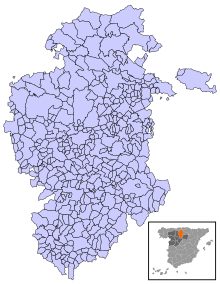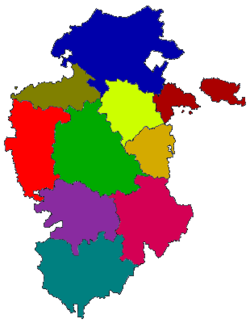Province of Burgos
This article includes a list of generalreferences,butit lacks sufficient correspondinginline citations.(October 2018) |
Burgos | |
|---|---|
 Provincial Palace (19th century) in Burgos, seat of the Diputación de Burgos, the province governing body | |
 Map of Spain with Burgos highlighted | |
| Coordinates:42°23′N3°40′W/ 42.383°N 3.667°W | |
| Country | Spain |
| Autonomous community | Castile and León |
| Capital | Burgos |
| Government | |
| • President | César Rico Ruiz (PP) |
| Area | |
| • Total | 14,292 km2(5,518 sq mi) |
| • Rank | Ranked 11th |
| 2,78% of Spain | |
| Population ()[1] | |
| • Rank | Ranked 36th |
| 0,80% of Spain | |
| Demonym(s) | Spanish:burgalés/a English:burgalese |
| ISO 3166 code | ES-BU |
| Official language(s) | Spanish |
| Parliament | Cortes Generales |
| Website | www |
Theprovince of Burgosis aprovinceof northernSpain,in the northeastern part of theautonomous communityofCastile and León.It is bordered by the provinces ofPalencia,Cantabria,Vizcaya,Álava,La Rioja,Soria,Segovia,andValladolid.Burgos is the province of Spain that has borders with most provinces. Its capital is the city ofBurgos.
TheCartularies of Valpuestafrom the monastery Santa María de Valpuesta, in Burgos, are considered to be the oldest known documents containing words written in theSpanish language.[2]
Overview
[edit]Since 1964,archaeologistshave been working at numerous areas of theArchaeological Site of Atapuerca,where they have found ancienthominidandhumanremains, the former dating to more than one million years ago, withartefactsfrom thePalaeolithicandBronze Agesof man. The site has been designated aUNESCOWorld Heritage Site.
The province has an area of 14,300 km2(5,500 sq mi) and a population of approximately 375,000 of whom nearly half live in the capital. The other locations higher than 20,000 inhabitants apart from Burgos areMiranda de EbroandAranda de Duero,both very industrialized. TheSierra de la Demanda,the northwesternmost end of theSistema Ibérico,is located in Burgos Province.[3]
The most important rivers in the province are theEbroand theDuero.The riverDuerois in the south of the province and leads to theAtlantic OceanatPorto, Portugal.Planted near it is a notablevineyard,Ribera de Duero.The north and south-east of the province are mountainous. The Ebro flows to theMediterranean Sea.
InValpuestathe oldest texts in theSpanish languagehas been found, dating from the tenth century.[4]
Transportation is developed through a wide net of highways and roads. Besides, the province is served by theBurgos Airport,and was to have receivedHigh-speed railAVEaround 2016.
History
[edit]
In theAtapuercaarea, archaeologists have found evidence of occupation by hominids and humans for more than one million years. Discoveries have included the earliest hominid skull in Europe.
TheCeltiberianregion that became Burgos was inhabited by theMorgobos,Turmodigi,Beronesand perhaps also thePellendones,the last inhabitants of the northern part of the Celtiberian region. According to theGreekhistorianPtolemy,the principal cities included:Brabum,Sisara,Deobrigula(nowadaysTardajos),Ambisna Segiasamon(Sasamón) andVerovesca(Briviesca). UnderRomancolonization, it was part ofHispania Citerior( "Hither Spain" ) and thenHispania Tarraconensis.
In the fifth century, theVisigothsdrove back theSuevi.In the eighth century, the Arabs occupied all ofCastiles.Alfonso III the Great,king of Leónreconquered the area around the middle of the ninth century, and built many castles for the defence of Christendom. Gradually the area was reconquered. The region came to be known as Castile (Latincastella), i.e. "land of castles". In the eleventh century, Burgos became the capital of theKingdom of Castile.
Population development
[edit]The historical population is given in the following chart:

Comarcas
[edit]The province of Burgos is divided in 10comarcas.
- Merindades
- Valle del Rudrón
- Ebro
- La Bureba
- Montes de Oca
- Alfoz de Burgos
- Sierra de la Demanda
- Odra y Pisuerga
- Arlanza
- Ribera del Duero
Administrative divisions
[edit]
The province of Burgos is divided into 371 municipalities, being the Spanish province with the highest number, although many of them have fewer than 100 inhabitants.
See also
[edit]Notes and references
[edit]- ^Municipal Register of Spain 2018.National Statistics Institute.
- ^"Origin and history of Spanish language: First manuscripts".2013. Archived fromthe originalon 2015-04-05.
- ^Sierra de la Demanda, Burgos, Sistema Ibérico
- ^Valpuesta Foundation is born with the aimn to study and promote Castilian since its very origins



